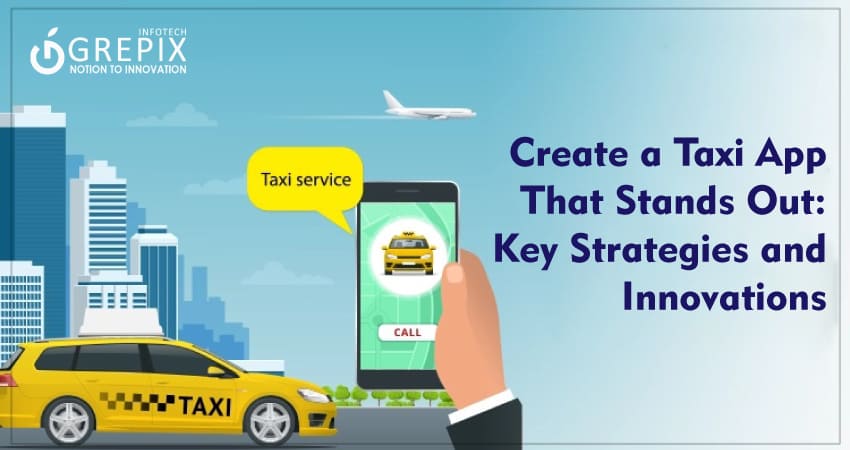How to Create a Taxi App That Stands Out: Key Strategies and Innovations
In today’s fast-paced world, the convenience of hailing a ride with a few taps on a smartphone has become an essential part of urban life. However, with numerous taxi apps flooding the market, simply providing a basic service is no longer enough. To truly capture the attention and loyalty of users, a taxi app must not only function seamlessly but also offer unique features and innovations that set it apart from the competition. This blog delves into the essential strategies and cutting-edge technologies that can help you create a taxi app that stands out, ensuring it not only meets but exceeds user expectations. Whether you are an entrepreneur looking to enter the market or an established business aiming to innovate, this comprehensive guide will provide valuable insights to drive your success.
Creating a standout taxi app requires understanding market trends, user needs, and integrating advanced features. Essential elements include a user-friendly interface, real-time tracking, multiple payment options, ride scheduling, and fare estimation. Advanced features like AI-powered dispatch, in-app chat support, multi-language options, driver ratings, and robust safety measures set your app apart. Innovative technologies such as blockchain, IoT, AR for navigation, voice recognition, and big data analytics enhance functionality. Effective monetization strategies, including surge pricing, subscription plans, in-app advertising, and premium services, drive revenue. Continuous improvement, user feedback, and strategic marketing ensure long-term success and user satisfaction.
How To Create a Taxi App
Creating a successful taxi app begins with a deep understanding of the market landscape. This involves two critical components: market research and defining your target audience.
Market Research
Before diving into development, conducting thorough market research is essential. This process helps you identify the current trends, user expectations, and gaps in existing taxi apps. Start by analyzing popular taxi apps to understand their strengths and weaknesses. Look into what competitors offer and pinpoint where they fall short. Are there features users consistently complain about? Is there a common need that remains unaddressed? This insight will not only guide your development process but also help you create a unique selling proposition (USP). By understanding the market dynamics and user pain points, you can develop an app that stands out by offering innovative solutions that meet unmet needs.
Target Audience
Defining your target audience is another crucial step in the development process. A one-size-fits-all approach rarely works in the competitive taxi app market. Are you focusing on urban commuters who need quick and efficient rides within the city? Or are you targeting airport travelers who require reliable, scheduled pickups? Perhaps your app is geared towards suburban users who might prioritize safety and affordability. Understanding your audience’s needs and preferences will help you design features that cater to them specifically. For instance, urban commuters might value features like real-time tracking and quick booking, while airport travelers might prioritize pre-scheduling and luggage support. By tailoring your app to the specific needs of your target audience, you can enhance user satisfaction and build a loyal customer base.
Core Features of a Taxi App
Developing a taxi app that excels in a competitive market requires integrating essential features that cater to user convenience and trust. Here are five core features that are indispensable for any successful taxi app:
User-friendly Interface
A clean, intuitive interface is crucial for any taxi app. Users should be able to book a ride with minimal clicks, ensuring a seamless experience. The design should be visually appealing and easy to navigate, with clear icons and straightforward instructions. A user-friendly interface not only enhances the user experience but also encourages repeat usage by making the booking process quick and hassle-free.
Real-time Tracking
Real-time GPS tracking is a fundamental feature that allows users to see their taxi’s location, estimated arrival time, and route. This level of transparency builds trust and significantly improves the user experience. By providing real-time updates, users feel more in control and informed about their ride, reducing anxiety and uncertainty.
Multiple Payment Options
Offering a variety of payment methods is essential to accommodate different user preferences. Include options such as credit/debit cards, digital wallets, and cash. This flexibility ensures that all users can conveniently pay for their rides in the manner they prefer, enhancing overall satisfaction and broadening your user base.
Ride Scheduling
Allowing users to schedule rides in advance is a highly valued feature. This is particularly useful for those planning airport transfers or early morning commutes. By enabling ride scheduling, your app can cater to users who need reliable transportation at specific times, ensuring they reach their destinations punctually.
Fare Estimation
Providing fare estimates before booking is crucial for transparency and user trust. This feature helps users make informed decisions and avoids any surprises when the ride ends. Fare estimation allows users to compare prices and choose rides that fit their budget, enhancing their overall experience and satisfaction with your service.
Advanced Features Of Your Taxi App
To stand out in a crowded market, integrating advanced features into your taxi app can significantly enhance the user experience and set your service apart from competitors. Here are some key advanced features to consider:
AI-Powered Dispatch System
Implementing an AI-powered dispatch system can revolutionize how rides are allocated. This technology ensures that the nearest available driver is assigned to each ride request, reducing wait times and improving overall efficiency. By optimizing driver allocation, AI dispatch systems can balance supply and demand more effectively, leading to higher customer satisfaction and better resource utilization.
In-app Chat Support
Integrating in-app chat support provides users with instant assistance. Whether they have questions about their ride, encounter issues, or need real-time help, quick and accessible support can significantly enhance customer satisfaction. This feature can also reduce the burden on customer service teams by addressing common queries and problems directly within the app.
Multi-Language Support
Offering multi-language support is crucial in catering to a diverse user base. By including multiple languages, your app becomes accessible to non-native speakers and users from different regions. This inclusion not only expands your market reach but also demonstrates a commitment to user convenience and inclusivity.
Driver Ratings and Reviews
Allowing users to rate and review drivers helps maintain high service standards. This feedback system encourages drivers to provide excellent service and helps new users make informed decisions when choosing a ride. Positive reviews can build trust and credibility, while constructive feedback can guide improvements in driver performance and overall service quality.
Safety Features
Integrating robust safety features is essential for building trust and ensuring user safety. Include emergency buttons that allow users to quickly alert authorities or contacts in case of an emergency. Ride-sharing features enable users to share their trip details with friends or family for added security. Conducting thorough background checks for drivers adds another layer of safety, ensuring that only qualified and trustworthy individuals are behind the wheel. Prioritizing safety can be a significant differentiator in the competitive taxi app market.
Innovative Technologies for a Cutting-edge Taxi App
To create a truly standout taxi app, leveraging the latest technological advancements can provide significant advantages. Here are some innovative technologies to consider integrating into your taxi app:
Blockchain for Secure Transactions
Utilizing blockchain technology can revolutionize the security and transparency of transactions within your taxi app. Blockchain ensures that all transactions are secure, tamper-proof, and transparent, which helps in preventing fraud and ensuring data integrity. This fosters user trust as they can be confident that their payment and personal information is protected through an immutable ledger. By adopting blockchain, you also provide a decentralized platform that can handle various payment methods efficiently.
IoT for Connected Vehicles
Incorporating the Internet of Things (IoT) creates a network of connected vehicles that can communicate in real-time. IoT can offer real-time vehicle diagnostics, allowing for predictive maintenance that minimizes downtime and enhances vehicle performance. Additionally, IoT can improve passenger safety by monitoring critical vehicle parameters and providing alerts for potential issues before they become problems. Connected vehicles can also share data with traffic management systems to optimize routes and reduce congestion.
Augmented Reality (AR) for Navigation
Augmented Reality (AR) can elevate the navigation experience for both drivers and passengers. AR can overlay real-time directions, landmarks, and points of interest directly onto the user’s view, making it easier to locate their ride or navigate to their destination. For drivers, AR can highlight the best routes, display traffic information, and show customer pickup locations more clearly, enhancing the overall driving experience and efficiency.
Voice Recognition
Integrating voice recognition technology enables hands-free operation, significantly enhancing user convenience. Users can book rides, change destinations, and communicate with drivers using voice commands. This feature is especially useful for users who are on the go or have their hands full, as it provides a seamless and intuitive way to interact with the app. Voice recognition can also assist drivers by allowing them to accept rides, navigate routes, and send updates without taking their hands off the wheel.
Big Data Analytics
Leveraging big data analytics provides deep insights into user behavior and preferences. By analyzing vast amounts of data, you can identify patterns and trends that inform personalized marketing strategies and improve service quality. Big data can help in optimizing routes, predicting peak demand times, and tailoring promotions to specific user segments. This data-driven approach not only enhances operational efficiency but also ensures that the app meets the evolving needs of its users, providing a more personalized and satisfying experience.
Monetization Strategies
To ensure the financial success of your taxi app, it’s essential to implement effective monetization strategies that maximize revenue while providing value to your users. Here are some key strategies to consider:
Surge Pricing
Implementing dynamic pricing, commonly known as surge pricing, allows you to adjust fares based on demand. During peak times, such as rush hours or bad weather conditions, prices can be increased to balance supply and demand. Surge pricing maximizes revenue by capitalizing on high demand periods while also incentivizing more drivers to be available during these times. It’s important to communicate surge pricing clearly to users to maintain transparency and trust.
Subscription Plans
Offering subscription plans can provide steady revenue and encourage customer loyalty. For frequent users, subscription plans offer cost savings and convenience. For instance, you can offer a monthly or yearly subscription that includes a certain number of rides at a discounted rate. This model not only secures a regular income stream but also fosters a long-term relationship with users who prefer predictable and budget-friendly options.
In-app Advertising
Incorporating in-app advertising is an effective way to generate additional revenue. Partner with local businesses to display targeted ads that are relevant to your users. For example, you could feature ads for nearby restaurants, retail stores, or entertainment venues. This strategy can be particularly lucrative if your app has a large user base and high engagement rates. Ensure that the ads are non-intrusive and add value to the user experience rather than detract from it.
Premium Services
Offering premium services caters to users who are willing to pay more for enhanced experiences. Examples of premium services include luxury rides with high-end vehicles, priority pickups that reduce wait times, or specialized services such as package deliveries. Premium options can significantly increase your revenue per ride by providing differentiated services that appeal to higher-income users or those seeking more convenience and comfort. Additionally, premium services can enhance your brand’s image by associating it with quality and exclusivity.
Marketing Your Taxi App
Effective marketing is crucial for the success of your taxi app. By implementing a combination of digital strategies and strategic partnerships, you can attract new users, retain existing ones, and build a strong brand presence. Here are some key marketing strategies to consider:
- SEO (Search Engine Optimization): Optimize your website and app store listings with relevant keywords to improve search engine rankings. This increases organic traffic and makes it easier for potential users to find your app.
- Social Media Marketing: Leverage platforms like Facebook, Instagram, Twitter, and LinkedIn to engage with your audience. Share updates, promotions, and user testimonials to build a community around your app. Utilize targeted ads to reach specific demographics.
- Email Campaigns: Use email marketing to keep users informed about new features, promotions, and updates. Personalized emails can help re-engage inactive users and encourage loyalty among existing ones.
Partnerships
Forming strategic partnerships with businesses, hotels, and airports can significantly increase your app’s visibility and user base:
- Businesses: Collaborate with local businesses to offer exclusive discounts or promotions to their employees and customers. This can drive user acquisition and increase ride bookings.
- Hotels: Partner with hotels to provide their guests with reliable transportation options. Hotels can recommend your app to guests, ensuring a steady stream of users.
- Airports: Establish partnerships with airports to become the preferred taxi service for travelers. Offer special deals for airport transfers and ensure a seamless experience for passengers.
Referral Programs
Implementing referral programs encourages word-of-mouth marketing, which can be highly effective in driving user growth:
- Incentives: Offer incentives such as ride credits or discounts to users who refer friends and family to your app. This motivates existing users to spread the word and brings in new users.
- Easy Sharing: Make it easy for users to share referral links through social media, messaging apps, and email. The simpler the process, the more likely users are to participate.
Influencer Marketing
Collaborating with influencers can amplify your reach and lend credibility to your brand:
- Identify Influencers: Find influencers who align with your brand values and have a strong following in your target market. This could include travel bloggers, local celebrities, or social media personalities.
- Campaigns: Work with influencers to create engaging content that showcases your app’s features and benefits. Influencers can share their experiences using your app, participate in promotional events, and create sponsored posts.
- Authenticity: Ensure that influencer partnerships feel authentic and genuine. Influencers who genuinely like and use your app can have a more significant impact on their followers.
Continuous Improvement and User Feedback
To ensure the long-term success and relevance of your taxi app, it is crucial to focus on continuous improvement and actively incorporate user feedback. This approach not only enhances user satisfaction but also keeps your app competitive in an ever-evolving market.
Regular Updates
Regularly updating your app is vital for maintaining a high-quality user experience. Updates should focus on:
- Bug Fixes: Address and resolve any bugs or issues promptly to ensure a smooth and reliable user experience. Frequent updates that fix bugs demonstrate your commitment to maintaining a stable platform.
- New Features: Continuously innovate by adding new features that enhance functionality and user experience. Stay ahead of competitors by incorporating the latest technologies and trends.
- Performance Improvements: Optimize the app’s performance to ensure fast load times, seamless navigation, and minimal crashes. Performance improvements can significantly enhance user satisfaction and retention.
User Feedback
Encouraging and actively utilizing user feedback is essential for aligning your app with user needs and expectations:
- Feedback Channels: Provide multiple channels for users to submit feedback, such as in-app surveys, feedback forms, and customer support. Make it easy for users to share their thoughts and suggestions.
- Actively Listen: Regularly review user feedback and identify common themes and areas for improvement. Acknowledge and appreciate user input to show that you value their opinions.
- Implement Changes: Make data-driven decisions based on user feedback. Implement changes and improvements that address user concerns and enhance their experience. Communicate these changes to users to show that their feedback leads to tangible improvements.
Performance Monitoring
Monitoring app performance using analytics tools is crucial for identifying areas for improvement and making informed decisions:
- Key Metrics: Track key metrics such as user retention, engagement, and ride completion rates. These metrics provide insights into how users interact with your app and where potential issues may lie.
- User Behavior: Analyze user behavior to understand how they navigate through your app, which features they use the most, and where they encounter difficulties. This data helps prioritize areas that need attention.
- Benchmarking: Compare your app’s performance against industry benchmarks and competitors. Identify gaps and opportunities for improvement to stay competitive.
Case Studies: Successful Taxi Apps

Examining the strategies and innovations of successful taxi apps provides valuable insights into what makes an app stand out in a competitive market. Here are three notable examples:
Validating the Idea
Conduct surveys, focus groups, and interviews to gather feedback on your app idea. This step will help you refine your concept and ensure there's a demand for your app in the market.
1. Uber

Uber success is largely attributed to its user-centric design and innovative approach. Key factors include:
- User-friendly Interface: Uber's app is designed for ease of use, allowing users to book rides quickly and efficiently with minimal effort. The intuitive interface makes the process seamless for users of all ages.
- Real-time Tracking: Uber's real-time GPS tracking feature enhances transparency and user trust. Users can track their ride’s progress, estimated arrival time, and route, which adds to the convenience and reliability of the service.
- Multiple Payment Options: By offering various payment methods, including credit/debit cards, digital wallets, and cash in certain regions, Uber accommodates diverse user preferences and ensures a smooth payment process.
- Surge Pricing: Uber's innovative surge pricing model adjusts fares based on demand, maximizing revenue during peak times while balancing supply and demand. This dynamic pricing strategy has been crucial to Uber’s profitability and operational efficiency.
- Extensive Marketing Campaigns: Uber’s marketing strategies, including promotions, partnerships, and referral programs, have significantly contributed to its global dominance. The company has effectively leveraged digital marketing and local campaigns to build brand awareness and attract users.
2. Lyft

Lyft differentiates itself through a focus on community and exceptional customer service. Key elements of Lyft's approach include:
- Community Focus: Lyft fosters a sense of community and camaraderie among its users and drivers. The company’s friendly branding and initiatives, such as the pink mustache, have helped create a positive and approachable image.
- Variety of Ride Options: Lyft offers a range of ride options to cater to different user segments, including shared rides (Lyft Line), luxury rides (Lyft Lux), and standard rides (Lyft). This variety allows users to choose rides based on their needs and budget.
- Customer Service: Lyft places a strong emphasis on customer service, ensuring that users have a positive experience from booking to ride completion. The company’s focus on driver quality and user feedback helps maintain high service standards.
- Social Responsibility: Lyft’s commitment to social responsibility, such as carbon-neutral rides and support for community causes, resonates with socially conscious users and enhances the brand’s reputation.
3.Grab

Grab has emerged as a leading ride-hailing service in Southeast Asia by focusing on localization and diversification. Key aspects of Grab's success include:
- Localized Services: Grab tailors its services to meet the specific needs of different Southeast Asian markets. This includes offering unique services like GrabBike for motorcycle taxis in Indonesia and GrabFood for food delivery, catering to local demands.
- Super App Strategy: Grab has evolved into a super app, providing a range of services beyond ride-hailing, such as food delivery, digital payments (GrabPay), and financial services. This diversification attracts a broader user base and increases user engagement.
- Safety and Trust: Grab places a strong emphasis on safety and trust, incorporating features like in-app emergency buttons, insurance coverage, and rigorous driver background checks. This focus on safety enhances user confidence in the service.
- Strategic Partnerships: Grab has formed partnerships with local governments, financial institutions, and other businesses to expand its reach and improve service offerings. These collaborations have helped Grab establish a strong presence in the region.
4. DiDi Chuxing

DiDi Chuxing, the dominant ride-hailing app in China, has leveraged technology and strategic expansion to maintain its market leadership. Key factors in DiDi’s success include:
- Comprehensive Services: DiDi offers a wide range of services, including taxi hailing, private car hailing, carpooling (DiDi Express), luxury rides (DiDi Premier), and even bike-sharing. This comprehensive service portfolio caters to various user needs.
- Advanced Technology: DiDi uses AI and big data analytics to optimize ride dispatching, improve route planning, and enhance overall service efficiency. This technological edge ensures faster and more reliable rides for users.
- Safety Innovations: DiDi has implemented numerous safety features, such as in-ride audio recording, emergency buttons, and real-time trip sharing with contacts. These measures prioritize user safety and build trust.
- Global Expansion: DiDi has expanded internationally, acquiring ride-hailing companies in different regions and investing in global markets. This strategic expansion helps DiDi diversify its user base and revenue streams.
5. Ola

Ola’s strength lies in its localization strategy and ability to adapt to diverse markets. Key aspects of Ola's success include:
- Localization: Ola tailors its services to meet the unique needs of different regions. For example, in India, Ola offers auto-rickshaw rides and bike taxis, catering to local transportation preferences and conditions. This localization strategy helps Ola resonate with users and gain market share.
- Variety of Services: Ola provides a wide range of services, including Ola Prime for premium rides, Ola Share for carpooling, and Ola Rentals for hourly rentals. This variety allows Ola to serve different customer needs and preferences effectively.
- Technology Integration: Ola leverages technology to enhance the user experience, offering features such as real-time tracking, fare estimation, and multiple payment options. These technological advancements make the service convenient and reliable for users.
- Partnerships and Promotions: Ola forms strategic partnerships with businesses, hotels, and airports to increase visibility and attract users. The company also runs extensive promotional campaigns to incentivize new user sign-ups and encourage ride bookings.
Future Trends in Taxi App Development

Staying ahead of emerging trends is crucial for the long-term success of a taxi app. Here are some future trends that are poised to revolutionize the industry:
Autonomous Vehicles
The advent of autonomous vehicles is set to transform the taxi industry by providing safer, more efficient, and cost-effective transportation solutions. Investing in autonomous technology can position your app at the forefront of this transformation:
- Safety and Efficiency: Autonomous vehicles have the potential to significantly reduce accidents caused by human error. They can also optimize routes and manage traffic better, resulting in shorter travel times and reduced congestion.
- Cost Savings: Without the need for drivers, operational costs can be lowered, potentially reducing fare prices for users. This can make taxi services more affordable and accessible to a broader audience.
- User Experience: Autonomous vehicles can offer a consistent and reliable experience, ensuring that users get the same level of service every time. Enhanced features, such as personalized in-car entertainment and automated assistance, can further improve the user experience.
Sustainable Mobility
Sustainability is becoming increasingly important to users, and integrating environmentally friendly options can attract a new segment of eco-conscious customers:
- Electric and Hybrid Vehicles: Transitioning to electric or hybrid vehicles can significantly reduce the carbon footprint of your fleet. Promoting the use of green vehicles can appeal to users who prioritize sustainability and are willing to support eco-friendly businesses.
- Carbon Offset Programs: Implementing carbon offset programs can help neutralize emissions from your operations. This initiative can enhance your brand's reputation as an environmentally responsible company.
- Green Marketing: Highlighting your commitment to sustainability in marketing campaigns can differentiate your app and attract users who are concerned about environmental impact.
Micro-Mobility Solutions
Micro-mobility solutions, such as e-scooters and bike rentals, cater to the growing demand for convenient, short-distance transportation options:
- Convenience: E-scooters and bike rentals provide a flexible and convenient way for users to travel short distances, particularly in congested urban areas where traditional taxis may not be practical.
- Affordability: These micro-mobility options are typically more affordable than traditional taxi rides, making them accessible to a wider range of users, including those who may not frequently use taxis.
- Integration: Offering micro-mobility solutions within your app can provide users with a comprehensive transportation service, allowing them to choose the most suitable option for their needs. This integration can enhance user loyalty by offering greater flexibility and convenience.
Conclusion
Creating a standout taxi app involves more than just developing a functional platform; it requires a deep understanding of market trends, user needs, and technological advancements. By integrating user-friendly interfaces, real-time tracking, multiple payment options, and advanced features like AI-powered dispatch and blockchain security, you can significantly enhance the user experience and differentiate your app from the competition. Moreover, embracing future trends such as autonomous vehicles and sustainable mobility solutions will position your app as a forward-thinking leader in the industry. Continuous improvement based on user feedback and regular updates will ensure long-term success and user satisfaction. Embrace these strategies and innovations to develop a taxi app that not only stands out but also drives substantial growth and customer loyalty in the competitive landscape.
By developing on-demand taxi app solutions for your company or startup, you can strengthen your connection with customers and attract numerous potential clients.
Grepix Infotech is a leading taxi app development company, ready to help your business create exceptional mobile app solutions in the USA or India. Our experienced team of developers specializes in Android, iOS, and Enterprise app development, ensuring that your business needs are expertly addressed.
Launch your vision with our mobile app development company, where innovation meets excellence to create cutting-edge mobile solutions.








